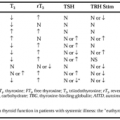SUBACUTE THYROIDITIS
Part of “CHAPTER 46 – THYROIDITIS“
ETIOLOGY
Subacute thyroiditis is an inflammatory disorder of the thyroid thought to be viral in origin. Previously, this condition was termed granulomatous thyroiditis, De Quervain thyroiditis, struma granulomatosa, and pseudotuberculous thyroiditis. The pathologic hallmarks are granulomas and pseudo giant cells (Fig. 46-1). Evidence that suggests a viral infection includes the following:
Subacute thyroiditis often occurs after an upper respiratory tract infection or during a viral epidemic.
There is no associated polymorphonuclear leukocytosis.
Coxsackie virus antibody titers have been noted to rise.7
The mumps virus has been cultured from thyroid tissue of patients with subacute thyroiditis.8
The process is self-limited.
 FIGURE 46-1. Subacute (granulomatous) thyroiditis. Note the numerous giant cells. ×125 (From LiVolsi VA, LoGerfo P, eds. Thyroiditis. Boca Raton, FL: CRC Press, 1981.) |
All current evidence suggests that subacute thyroiditis is not an autoimmune disease. Although low levels of antithyroid antibodies may appear transiently during the course of the disorder, the levels are not of the same magnitude seen in patients with other autoimmune thyroid disorders. Subjects with subacute thyroiditis, but not those with Hashimoto disease, have a higher frequency of a certain human leukocyte antigen (HLA) haplotype (HLA-B35)7; it is possible that this HLA association may reflect a genetic susceptibility to subacute thyroiditis after various viral infections.9
Stay updated, free articles. Join our Telegram channel

Full access? Get Clinical Tree






